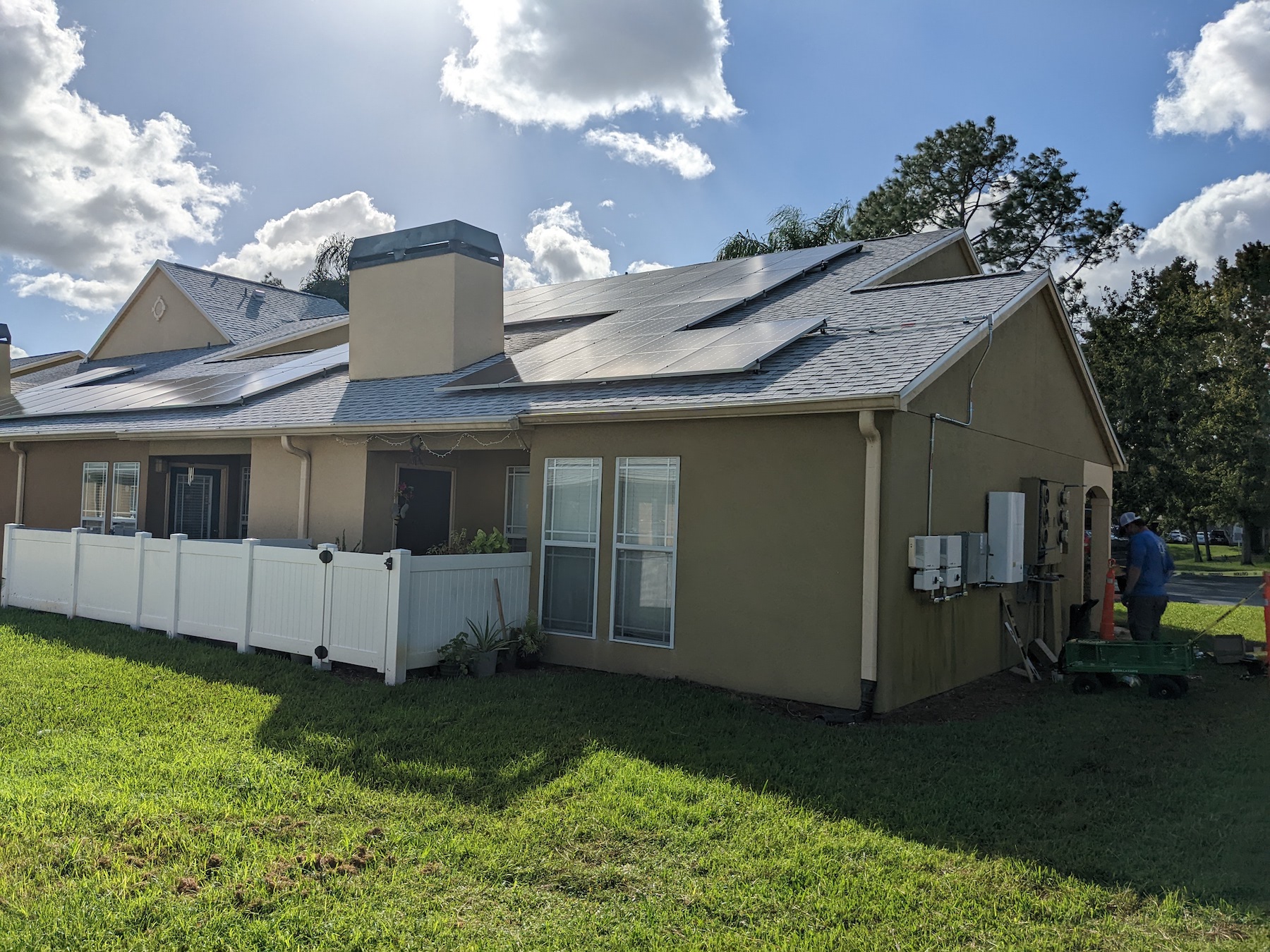Last January, a survey of 10,237 U.S. adults, conducted by Pew Research Center, found that 8% had installed solar panels on their homes, and another 39% had given serious thought to installing solar panels within the previous 12 months.
However, the growth in solar energy alternatives has been mostly confined to commercial buildings and to single-family detached households. Lower-income households, which represent 43% of the U.S. population, are more likely to reside in multifamily buildings that don’t have the mechanical/electrical infrastructure to distribute rooftop-captured solar energy to individual apartments.
Allume Energy is looking to change that. The Australia-based company, with offices in Los Angeles, recently completed its first successful U.S. deployment of SolShare, the company’s shared solar energy technology. Its pilot in the U.S. is a complex in Orlando, Fla., where Allume has connected 65 apartments. Another smaller project in Jackson, Miss., has nine apartment connections. In Jackson, the local utility lowered the application cost because the building caters to lower-income tenants.
Controlling the energy flow

Here’s how SolShare works: Energy from a rooftop solar array flows into the building’s inverter that changes the energy to AC electricity. The inverter sends the electrical current through the SolShare unit to grid meters that are hooked up to apartments. (One SolShare unit can feed up to 10 grid meters.) The electrical distribution moves among the grid boxes several times per second, so when one meter is configured with limits for a particular tenant, the incoming energy gets allocated to the other meters. Any overflow can be sold back to the local energy grid.
Melissa Bergsneider, an executive account manager for Allume Energy, explains that prior to the introduction of the SolShare solution, most landlords were distributing solar energy only to their buildings’ common areas, like a lobby or gym. Those that have been delivering solar energy to apartments were faced with the challenge of how to divide the energy if, for example, a tenant goes on vacation, or an apartment unit is vacant.
SolShare, on the other hand, is “behind the meter,” and its software lets tenants monitor the energy usage. Landlords can still set the rules for how solar energy is allocated throughout the building. One of the advantages of this system, she says, is that it can connect as many apartments as needed. And unlike other so-called “social” solar systems, SolShare provides solar energy at the point of generation rather than exporting it back to the grid.
Allume Energy, which has been in business since 2015, has found that SolShare is reducing tenants’ energy bill, on average, by 30-35%. Bergsneider says that some landlords have been offering Solar as a Service, and are charging tenants a monthly fee for access.
Tax credit boosts demand

Bergsneider declined to disclose SolShare’s cost. She does note, though, that on past projects, SolShare accounted for between 6% and 8% of the total system installation.
Allume Energy’s primary target is low-rise attached rental houses, although it has installed SolShare in mixed-use buildings with commercial tenants. Most of SolShare’s demand is for retrofitting existing buildings, and Allume has been working with solar installation partners; the company has a training program, and a team member is on site for each installation.
Bergsneider attributes demand to the Solar Investment Tax Credit, which offers a 30% credit for individuals installing solar systems on residential properties. This tax credit was extended as part of the August 2022 passage of the Inflation Reduction Act. Bergsneider says there’s a 20% “adder” credit for properties with lower-income residents.
SolShare also helps developers and landlords decarbonize their buildings as part of their Environmental, Social, and Governance goals.
Currently, Allume Energy is focusing its expansion on the Southeast in the U.S. It has also been getting interest for SolShare from building owners in the Northeast and West Coast. Internationally, Allume Energy is targeting Australia, New Zealand, and the United Kingdom.
Related Stories
Mass Timber | May 17, 2024
Charlotte's new multifamily mid-rise will feature exposed mass timber
Construction recently kicked off for Oxbow, a multifamily community in Charlotte’s The Mill District. The $97.8 million project, consisting of 389 rental units and 14,300 sf of commercial space, sits on 4.3 acres that formerly housed four commercial buildings. The street-level retail is designed for boutiques, coffee shops, and other neighborhood services.
Adaptive Reuse | May 15, 2024
Modular adaptive reuse of parking structure grants future flexibility
The shift away from excessive parking requirements aligns with a broader movement, encouraging development of more sustainable and affordable housing.
Affordable Housing | May 14, 2024
Brooklyn's colorful new affordable housing project includes retail, public spaces
A new affordable housing development located in the fastest growing section of Brooklyn, N.Y., where over half the population lives below the poverty line, transformed a long vacant lot into a community asset. The Van Sinderen Plaza project consists of a newly constructed pair of seven-story buildings totaling 193,665 sf, including 130 affordable units.
MFPRO+ News | May 13, 2024
Special multifamily report indicates ‘two supply scenarios’
Could we be headed towards a “period of stagflation?” That's the question Andrew Semmes, Senior Research Analyst, poses in the Matrix May 2024 Multifamily Rent Forecast update.
MFPRO+ News | May 10, 2024
HUD strengthens flood protection rules for new and rebuilt residential buildings
The U.S. Department of Housing and Urban Development (HUD) issued more stringent flood protection requirements for new and rebuilt homes that are developed with, or financed with, federal funds. The rule strengthens standards by increasing elevations and flood-proofing requirements of new properties in areas at risk of flooding.
Adaptive Reuse | May 9, 2024
Hotels now account for over one-third of adaptive reuse projects
For the first time ever, hotel to apartment conversion projects have overtaken office-to-residential conversions.
Mass Timber | May 8, 2024
Portland's Timberview VIII mass timber multifamily development will offer more than 100 affordable units
An eight-story, 72,000-sf mass timber apartment building in Portland, Ore., topped out this winter and will soon offer over 100 affordable units. The structure is the tallest affordable housing mass timber building and the first Type IV-C affordable housing building in the city.
MFPRO+ News | May 1, 2024
On the Domino Sugar refinery site, new Brooklyn condominiums offer views of the Manhattan skyline
In Brooklyn, New York’s Williamsburg neighborhood, the new One Domino Square is the first condominium development and the third ground-up residential building on the site of the Domino Sugar refinery. The 700,000-sf project is adjacent to Domino Square and anchors a new 11-acre public park.
MFPRO+ News | Apr 29, 2024
World’s largest 3D printer could create entire neighborhoods
The University of Maine recently unveiled the world’s largest 3D printer said to be able to create entire neighborhoods. The machine is four times larger than a preceding model that was first tested in 2019. The older model was used to create a 600 sf single-family home made of recyclable wood fiber and bio-resin materials.
Senior Living Design | Apr 24, 2024
Nation's largest Passive House senior living facility completed in Portland, Ore.
Construction of Parkview, a high-rise expansion of a Continuing Care Retirement Community (CCRC) in Portland, Ore., completed recently. The senior living facility is touted as the largest Passive House structure on the West Coast, and the largest Passive House senior living building in the country.

















